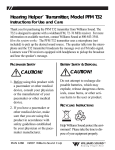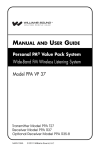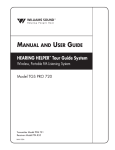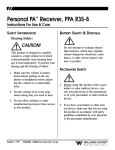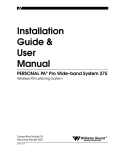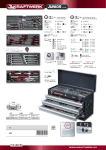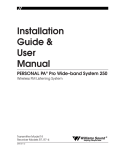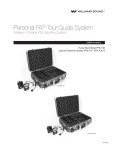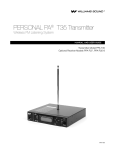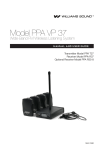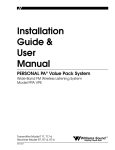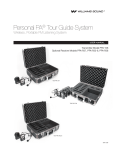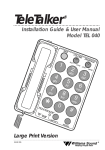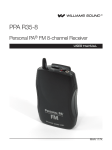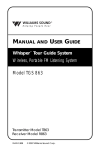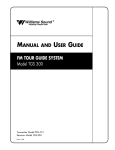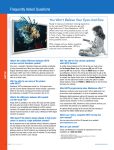Download PPA T27 Manual
Transcript
® MANUAL AND USER GUIDE Personal PA™ Value Pack System Wide-Band FM Wireless Listening System Model PPA VP Transmitter Model PPA T27 Receiver Model R35 Optional Receiver Model R35-8 MAN 128C © 2008 Williams Sound Corp. PERSONAL PA™ VALUE PACK SYSTEM, MODEL PPA VP INSTALLATION GUIDE & USER MANUAL CONTENTS PAGE System Overview . . . . . . . . . . . . . . . . . . . . . . . . . . . . . . . . . . .4 T27 Transmitter Instructions . . . . . . . . . . . . . . . . . . . . . . . . .5-7 T27 Features and Controls . . . . . . . . . . . . . . . . . . . . . . . . .5 Antenna Connection . . . . . . . . . . . . . . . . . . . . . . . . . . . . . .5 Power Connection . . . . . . . . . . . . . . . . . . . . . . . . . . . . . . . .6 Selecting a Frequency . . . . . . . . . . . . . . . . . . . . . . . . . . . . .6 Connecting an Audio Source . . . . . . . . . . . . . . . . . . . . . . . .7 Adjusting the Audio Source . . . . . . . . . . . . . . . . . . . . . . . .7 Safety Information . . . . . . . . . . . . . . . . . . . . . . . . . . . . . . . . . .8 Recycling Instructions . . . . . . . . . . . . . . . . . . . . . . . . . . . . . . .9 Receiver Instructions . . . . . . . . . . . . . . . . . . . . . . . . . . . . .10-17 R35 Receiver Use Instructions . . . . . . . . . . . . . . . . . . . . .10 R35 Receiver Frequency Change Instructions . . . . . . . . .12 R35-8 Receiver Use Instructions . . . . . . . . . . . . . . . . . . . .14 R35/R35-8 Belt Clip Instructions . . . . . . . . . . . . . . . . . . .16 Using A Receiver With A Hearing Aid . . . . . . . . . . . . . .17 Receiver Management Suggestions . . . . . . . . . . . . . . . . . .17 Battery Information . . . . . . . . . . . . . . . . . . . . . . . . . . . . . . . .18 Troubleshooting Guide . . . . . . . . . . . . . . . . . . . . . . . . . . . . . .19 Warranty . . . . . . . . . . . . . . . . . . . . . . . . . . . . . . . . . . . . . . . . .21 System Specifications . . . . . . . . . . . . . . . . . . . . . . . . . . . .23-25 ® 3 SYSTEM OVERVIEW Thank you for purchasing the Personal PA Value Pack System from Williams Sound Corp. The PPA VP System is a Wideband FM Listening System which operates in the 72-76 MHz frequency band. Designed for hearing assistance in places of public access, the PPA VP is for those who need help overcoming background noise, reverberation, or distance from the sound source. The versatile PPA VP is easily integrated with your existing sound system or can be used with a microphone as a stand-alone system. The system has two principal parts: the T27 Transmitter and the R35 Receiver. Much like a miniature radio station, the Transmitter and microphone pick up the sounds you want to hear and broadcast them over an FM radio signal. The receivers are used to pick up the broadcast up to 500 feet (152 m) away, or 1000 feet (305 m) with the optional ANT 005 coaxial antenna. To avoid difficulties, please read through these instructions as you begin to use the system. Then save the manual for questions that arise as you continue to use your PERSONAL PA Value Pack System. If you have any problems with this Williams Sound product, don’t hesitate to call us toll-free at 1-800-843-3544. FIG. 1: OVERALL SYSTEM DIAGRAM Microphones Sound System Amplifier Loudspeakers Line-Level Output Line-Level Input R35 Wide-band Receivers w/Earphones 4 T27 Transmitter ® SETTING UP THE PPA VP PPA T27 Transmitter Instructions FIG. 2: FEATURES & CONTROLS Front View 123 4 1. Mic input jack, 3.5 mm 2. Audio Level Indicator 3. Audio Level Control 5 4. Frequency Display (LED) 5. Frequency Selector, Lock/Unlock Control Rear View 6 7 6. Power Input jack, 12VAC 7. Antenna Connector, 75 Ohms 8 8. Audio Input jack, RCAtype (Line Level, Unbalanced) STEP 1: SELECT LOCATION Position the PPA T27 transmitter near the audio source (i.e. sound system, mixer) from which it will receive audio. STEP 2: INSTALL THE ANTENNA Gently thread the ANT 021 rubber duckie antenna onto the stud recessed in the hole on the top of the transmitter. Note: The antenna output on the back of the unit has been defeated, as specified by FCC Rules. To use a remote antenna, contact your dealer or Williams Sound. ® 5 STEP 3: CONNECT THE POWER Locate the TFP 036 power supply cord equipped with the 5-pin DIN connector, then plug the connector into the “Power In” jack located in the back of the T27. Plug the power supply into the AC outlet. On power up, the number “8” will scroll across the T27 display while the system initializes. The system will then display the default system frequency (72.9 MHz) or the last selected frequency set by the user. STEP 4: SELECT THE FREQUENCY The T27 has 17 available channels in the 72-76 MHz band. By default, the T27 frequency is set to 72.9 MHz. To change the frequency on the T27, press and release the down “ ” or up “ ” frequency selector button until the desired frequency is displayed. After 3 seconds, the frequency selection will be set, and the audio will begin transmitting on the new frequency. NOTE: You can LOCK this selection to prevent others from accidently changing the frequency. To LOCK the desired frequency, press and hold both down “ ” and up “ ” frequency selector buttons for 3 seconds until the word “Loc” appears on the display. The frequency is now locked. Should the user press the frequency selector button while in “Lock” mode, the word “Loc” will be displayed for 2 seconds. To UNLOCK the desired frequency, press and hold both down “ ” and up “ ” frequency selector buttons for 3 seconds until the transmitter displays ”Un” then “Loc” on the display. The frequency is now unlocked. The user is now free to change the frequency on the T27 as needed. 6 ® STEP 5: CONNECT THE AUDIO SOURCE On the back of the T27, an RCA-type “Audio In” jack is available for connecting a line-level, unbalanced audio source. On the front of the T27, a 3.5mm “Mic Input” jack is available to connect a Williams Sound electret microphone. Connect the desired audio source to the T27 transmitter and proceed to Step 6. STEP 6: ADJUST THE AUDIO LEVEL With the audio source playing, use a small screwdriver or tuning wand to rotate the “Adjust” control on the front of the T27: 1) clockwise to increase the audio level; or 2) counterclockwise to decrease the audio level. Refer to the audio “Level” indicator LED on the front of the T27 as you make your adjustments: Audio Level Indicator LED 1.) Never On = Audio source is TOO LOW. 2.) Blinks occassionally = Audio source is OPTIMAL. 3.) Always on = Audio source is TOO HIGH. STEP 7: LISTEN WITH AN FM RECEIVER IMPORTANT: The FM receiver being used with the T27 transmitter will need to be on the same frequency as the transmitter. For R35 tuning instructions, see page 12. Install the receiver batteries, plug in the earphone, turn on the receiver and walk around the listening area. The signal should be clear and quite loud when the volume is turned up. See pages 10-13 for detailed R35 receiver instructions. ® 7 RECEIVER SAFETY INFORMATION HEARING SAFETY: CAUTION! The receiver is designed to amplify sounds to a high volume level which could potentially cause hearing damage if used improperly. To protect your hearing and the hearing of others: 1. Make sure the volume is turned down before putting on the earphone or headphone before adjusting the volume to a comfortable level. 2. Set the volume level at the minimum setting that you need to hear. 3. If you experience feedback (a squealing or howling sound), reduce the volume setting and move the microphone away from the earphone or headphone. 4. Do not allow children or other unauthorized persons to have access to this product. BATTERY SAFETY AND DISPOSAL: CAUTION! The receiver is supplied with disposable Alkaline batteries. Do not attempt to recharge disposable batteries, which may explode, release dangerous chemicals, cause burns, or other serious harm to the user or product. 8 ® PACEMAKER SAFETY: CAUTION! 1. Before using the receiver with a pacemaker or other medical device, consult your physician or the manufacturer of your pacemaker or other medical device. 2. If you have a pacemaker or other medical device, make sure that you are using this product in accordance with safety guidelines established by your physician or the pacemaker manufacturer. RECYCLING INSTRUCTIONS Help Williams Sound protect the environment! Please take the time to dispose of your equipment properly. Product Recycling for Customers in the European Union: Please do NOT dispose of your Williams Sound equipment in the household trash. Please take the equipment to an electronics recycling center; OR, return the product to the factory for proper disposal. Battery Recycling for Customers in the European Union: Please do NOT dispose of used batteries in the household trash. Please take the batteries to a retail or community collection point for recycling. 04/05/07 ® 9 PPA R35 RECEIVER INSTRUCTIONS The PPA R35 is a single-channel receiver operating on the 72-76 MHz bandwidth. It features on/off volume control, power and low battery indicator, and an earphone jack. FIG. 3 On/Off Volume Switch Earphone Jack "On" Indicator LED R35 Top R35 Front Instructions: BATTERY INSTALLATION Install two (2) AA alkaline or NiMH rechargeable batteries. Open the battery compartment by lifting the tab on the back of 10 ® the receiver with a finger. To remove depleted batteries, pull up on the fabric strip. IMPORTANT: If Alkaline (or non-rechargeable) batteries are being installed, slide the battery selection switch above the battery compartment to the “Alkaline” position. If installing NiMH (or rechargeable) batteries, slide the battery selection switch to the “NiMH” position. Press the batteries into place over the fabric strip. Be sure to observe proper polarity (+/-). Damage due to improper battery installation may void the warranty on the product. Close the battery door. When the sound becomes weak or distorted, replace or recharge the batteries. NOTE: The ON indicator will illuminate RED to indicate low battery. CONNECTING EARPHONES Plug the earphone into the “EAR” jack on the top of the unit. Only monophonic earphones will operate properly. If stereo headphones are used, sound will be heard only in one side of the headphones. Williams Sound evaluates each earphone and headphone used with the PPA R35 receiver; we can only assure optimum performance when Williams Sound earphones and headphones are used. OPERATING THE RECEIVER NOTE: First, make sure the PPA T27 transmitter is on and receiving good audio input. Check to make sure the receiver is on the same frequency as the transmitter. If the R35 receiver needs to be re-tuned (most Williams Sound receivers are set at the factory at 72.9 MHz), see page 12 for frequency change instructions. Turn the receiver on by rotating the volume control knob clockwise. The receiver’s ON indicator should illuminate green. Adjust the volume control for your comfort. To turn the receiver off, rotate the volume control knob counter-clockwise until it clicks off. The receiver’s ON indicator should go off. To maximize battery life, remember to turn the receiver off when it’s not in use. ® 11 PPA R35 FREQUENCY CHANGE INSTRUCTIONS Selecting a frequency for the R35 receiver requires an adjustment to the internal tuning coil. See Figure 4 to locate the coil to be adjusted. A plastic tuning wrench (PLT 005) will be needed to adjust the receiver’s tuning coil. Note: By default, most Williams Sound R35 receivers are set at the factory to 72.9 MHz. FIG. 4 R-35 The Receiver must be tuned with a weak and somewhat noisy signal. If tuned too close to the transmitter, with a strong signal, the most accurate tuning of the receiver is not possible. To Change the Frequency to Another Channel: STEP 1: Set the transmitter to the channel desired and remove the antenna. STEP 2: Connect an audio source to the transmitter such as a CD or cassette player or microphone. 12 ® STEP 3: Move the receiver about 25 feet away from the transmitter to set the tuning. STEP 4: Open the battery compartment. STEP 5: Locate the Tuning Coil (see Figure 4). The tuning coil is a small, square, shiny metal can with a tuning slug in the top center. STEP 6: With the earphone or headphone supplied with the receiver plugged into the Ear Jack, turn the volume control to a comfortable level, and listen for the transmitted signal. STEP 7: Gently put the tip of the tuning tool into the slot in the tuning slug. Be careful not to push hard on the slug so as not to damage the threads in the coil, and do not screw it down more than 3 turns into the coil. STEP 8: Turn the tuning slug in a counter-clockwise direction about two turns. Then, slowly turn the tuning slug in the clockwise direction until the signal is heard. There may be two signal points heard. The one which is received first is a false response. Be sure to continue tuning slightly further to the correct point, which will be much louder. Tune back and forth to find the center of the point of best response to the audio source being heard. STEP 9: Mark down the date, and if a new frequency has been chosen, mark it down inside the receiver case for future reference. ® 13 RECEIVER MODEL PPA R35-8 (OPTIONAL) The PPA R35-8 is an eight channel receiver, operating on 72-76 MHz bandwidth. It features a channel selection knob, volume on/off control, LED power and low battery indicator, and an earphone jack (See Figure 5A). FIG. 5A Headphone Jack "On"/Low Battery Indicator LED Channel Selector Knob On/Off Switch Volume Control R35-8 Top R35-8 Front BATTERY INSTALLATION Install two (2) AA alkaline or NiMH rechargeable batteries. Open the battery compartment by lifting the tab on the back of the receiver with a finger. To remove depleted batteries, pull up on the 14 ® fabric strip. IMPORTANT: If Alkaline (or non-rechargeable) batteries are being installed, slide the battery selection switch above the battery compartment to the “Alkaline” position. If installing NiMH (or rechargeable) batteries, slide the battery selection switch to the “NiMH” position. Press the batteries into place over the fabric strip. Be sure to observe proper polarity (+/-). Damage due to improper battery installation may void the warranty on the product. Close the battery door. When the sound becomes weak or distorted, replace or recharge the batteries. NOTE: The red LED “ON” indicator on top of the unit will flash to indicate low battery. CONNECTING EARPHONES Plug the earphone into the “Headphone” jack on the top of the unit. Only monophonic earphones will operate properly. If stereo headphones are used, sound will be heard only in one side. Williams Sound evaluates each earphone and headphone used with the PPA R35-8 receiver; we can only assure optimum performance when Williams Sound earphones and headphones are used. OPERATING THE RECEIVER Plug the earphone or headphone into the Headphone jack on the receiver’s control panel. Turn the receiver on by rotating the Volume control knob. The ON indicator should illuminate RED. Refer to the channel selection chart in FIG. 5B to choose from 8 FIG. 5B standard frequencies. Turn the channel selector knob to the 1 desired channel. IMPORTANT: Make sure the receiver frequen2 cy matches the transmitter frequency! Adjust the volume to a 3 comfortable listening level. To 4 turn the receiver off, rotate the Volume control knob to the left 5 until it clicks off. The ON indica6 tor should not be lit. To prolong the battery life of the unit, turn the receiver off when it is not in use. 7 8 ® 15 BELT CLIP INSTALLATION FOR PPA R35 AND PPA R35-8 TO INSTALL: Position the belt clip on the rear of the R-35 or R35-8 receiver as shown in Figure 6A. Turn the belt clip 180º left or right as shown in Figure 6B. The belt clip is now installed and ready for use. TO REMOVE: Turn the belt clip 180º so the edge points toward the top of the unit as shown in figure 6B. Gently pull the belt clip away from the unit to remove. FIG. 6B FIG. 6A – or – EARPAD CLEANING FOR PPA R35 Do not immerse the earphone in water or other cleaning agent. Foam pads may be removed and washed with a mild laundry soap solution, rinsed thoroughly, and air dried. You may also opt to purchase new foam pads. Call Customer Service for ordering information: 1-800-843-3544 16 ® USING A RECEIVER WITH A HEARING AID Williams Sound PPA Receivers can be used with hearing aids using three different methods: NECKLOOP TELECOIL COUPLER Neckloops are cords which hang around the neck and couple magnetically with T-Coil equipped hearing aids. SILHOUETTE TELECOIL COUPLER These telecoil couplers are worn behind the ear, right next to telecoil-equipped hearing aids. DIRECT AUDIO INPUT (DAI) CORD Direct Audio Input cords can be used with compatible hearing aids as well as with Cochlear Implant Processors. SUGGESTIONS FOR RECEIVER MANAGEMENT Different types of facilities will use different approaches for receiver management and earphone sanitation. Below are some options that customers have used successfully. Regular users purchase their own receiver and take care of their own batteries and earphone. Some facilities label the receiver and earphone with the names of regular users so each person uses the same receiver and earphone. Ushers issue receivers to people who request them. Earphones are sanitized after use. Foam ear cushions can be replaced or washed with a mild detergent, rinsed thoroughly and air-dried. The EAR 022 Surround Earphone can be sanitized with an alcohol pad. The receivers can be stored in a multiple compartment storage case with a credit card or driver's license left as collateral for the receiver. Regular users purchase their own earphone or headphone and bring them to use with receivers at the facility. ® 17 RECEIVER BATTERY INFORMATION SINGLE USE BATTERIES If the sound becomes weak or distorted, replace the battery. The indicator light may still be on, even with a battery that is weak. Do not leave dead batteries in the receivers. Battery corrosion is not covered by the Williams Sound five year warranty. !! WARNING !! DO NOT ATTEMPT TO RECHARGE SINGLE USE BATTERIES! The batteries may heat up and burst, causing possible injury and damage to the equipment. Avoid shorting the plus and minus battery terminals together with metal objects. Battery damage and burns can result! Use only Williams Sound supplied chargers and batteries! RECOMMENDED BATTERIES For Receiver: • BAT 001 AA non-rechargeable alkaline batteries • BAT 026 AA rechargeable NiMH only BATTERY LIFE For R35 Receiver: • 100 hours for BAT 001 AA non-rechargeable alkaline batteries • 56 hours for BAT 026 AA rechargeable NiMH batteries For R35-8 Receiver: • 50 hours for BAT 001 AA non-rechargeable alkaline batteries • 32 hours for BAT 026 AA rechargeable NiMH batteries FURTHER SUGGESTIONS Receivers SHOULD NOT be left charging continuously when not in use. Receivers should always be turned OFF while charging. 18 ® TROUBLE SHOOTING GUIDE Read through the manual and user guide carefully to verify proper setup and installation of your system. TRANSMITTER FREQUENCY DISPLAY (LED) NOT LIT. Make sure the wall transformer is plugged into the transmitter. Make sure the electrical outlet is on. NO SOUND THROUGH RECEIVERS. If some of the receivers work, but others don't, check for bad batteries or earphones on the receivers that aren't working. Check to see that the receiver frequency matches the transmitter frequency. On the transmitter, the frequency is illuminated on the LED panel on the front of the unit. On the receiver, there is a sticker on the inside of the battery door of the receiver. If these frequencies do not match, see Frequency Change Instructions on page 6 (transmitter) and page 12 (receiver). If none of the receivers work, check to see if the power is connected to the transmitter and the frequency display on the front of the transmitter is illuminated. Check to see if the transmitter is connected properly to the sound system. See page 7. Turn the screwdriver-adjust audio input level control on the front panel of the T27 transmitter clockwise to increase the audio level. Make sure that the audio light is flashing occasionally but not continuously. If you are not using an input signal from a sound system, make sure the Williams Sound microphone is plugged into the “Mic” jack on the front of the T27 transmitter. Make sure the antenna is installed and connected properly. See page 5. INSUFFICIENT RANGE, GOOD RECEPTION NEAR TRANSMITTER, POOR AT A DISTANCE Check to see if the antenna was installed correctly. If not, correct or replace the antenna. The signal should be clearly audible at least 100 ft with line of site to transmitter. Check to make sure no other transmitters (or other devices) are transmitting on the same frequency (channel). ® 19 SOUND THROUGH RECEIVERS IS LOUD, BUT DISTORTED. NOISE (ROOM NOISE OR ELECTRONIC NOISE) SEEMS TO GROW AFTER TALKING STOPS. AUDIO INDICATOR LIGHT Turn the screwdriver-adjust audio level control on the front of the T27 transmitter counter-clockwise to decrease the audio level. The audio indicator light should flash occasionally, but not be lit continuously. SOUND THROUGH THE RECEIVERS IS WEAK AND NOISY. Turn the screwdriver-adjust audio level control located on the T27 front panel clockwise to increase the input signal strength. The audio indicator light should flash occasionally. Increase the input signal level from the sound system. BUZZING 20 IS CONTINUOUSLY ON. OR HUMMING NOISE IN SOUND SYSTEM. There is nothing wrong with the T27 Transmitter. One or more pieces of equipment in the sound system are being disturbed by RF (Radio Frequency) signals produced by the T27. The most likely suspects are your amplifier, mixer, or tape deck. The RF gets into the other equipment primarily through the power cord, speaker wires, or unshielded inputs, all of which can act as antennas. Try the following steps: Move the Transmitter away from the other sound equipment. Make sensitive equipment more immune to RFI/EMI. The manufacturers of your audio equipment may offer application notes for this purpose. Williams Sound offers a document giving suggestions for improving RF immunity in existing audio equipment. (Technical Bulletin: Buzz Or Hum In The Sound System, FRM 531) Unless you have the necessary technical skills, this is best left to a qualified electronics repair technician. ® LIMITED WARRANTY Williams Sound products are engineered, designed, and manufactured under carefully controlled conditions to provide you with many years of reliable service. Williams Sound warrants the Personal PA Value Pack System against defects in materials and workmanship for FIVE (5) years. During the first five years from the purchase date, we will promptly repair or replace the Personal PA Value Pack System. Microphones, earphones, headphones, batteries, cables, carry cases, and all other accessory products carry a 90-day warranty. Chargers carry a 1 year warranty. WILLIAMS SOUND HAS NO CONTROL OVER THE CONDITIONS UNDER WHICH THIS PRODUCT IS USED. WILLIAMS SOUND, THEREFORE, DISCLAIMS ALL WARRANTIES NOT SET FORTH ABOVE, BOTH EXPRESS AND IMPLIED, WITH RESPECT TO THE PERSONAL PA VALUE PACK SYSTEM, INCLUDING BUT NOT LIMITED TO, ANY IMPLIED WARRANTY OF MERCHANTABILITY OR FITNESS FOR A PARTICULAR PURPOSE. WILLIAMS SOUND SHALL NOT BE LIABLE TO ANY PERSON OR ENTITY FOR ANY MEDICAL EXPENSES OR ANY DIRECT, INCIDENTAL OR CONSEQUENTIAL DAMAGES CAUSED BY ANY USE, DEFECT, FAILURE OR MALFUNCTIONING OF THE PRODUCT, WHETHER A CLAIM FOR SUCH DAMAGES IS BASED UPON WARRANTY, CONTRACT, TORT OR OTHERWISE. THE SOLE REMEDY FOR ANY DEFECT, FAILURE OR MALFUNCTION OF THE PRODUCT IS REPLACEMENT OF THE PRODUCT. NO PERSON HAS ANY AUTHORITY TO BIND WILLIAMS SOUND TO ANY REPRESENTATION OR WARRANTY WITH RESPECT TO THE PERSONAL PA VALUE PACK SYSTEM. UNAUTHORIZED REPAIRS OR MODIFICATIONS WILL VOID THE WARRANTY. ® 21 The exclusions and limitations set out above are not intended to, and should not be construed so as to contravene mandatory provisions of applicable law. If any part or term of this Disclaimer of Warranty is held to be illegal, unenforceable, or in conflict with applicable law by a court of competent jurisdiction, the validity of the remaining portions of this Disclaimer of Warranty shall not be affected, and all rights and obligations shall be construed and enforced as if this Limited Warranty did not contain the particular part or term held to be invalid. If you experience difficulty with your system, call Toll-Free for Customer Assistance: 1-800-843-3544 (U.S.A.) or 1-952-943-2252 (World) If it is necessary to return the system for service, your Customer Service Representative will give you a Return Authorization Number (RA) and shipping instruction. Pack the system carefully and send it to: Williams Sound Corp. Attn: Repair Dept. 10321 West 70th Street Eden Prairie, MN 55344 USA Your warranty becomes effective the date you purchase your system. Your returned warranty card is our way of knowing when you warranty begins. Please take a moment to fill it out and mail the enclosed card. You may also register your product online: www.williamssound.com/registration.aspx. This information will help us serve you better in the future. Thank you! 22 ® PERSONAL PA VALUE PACK SYSTEM SPECIFICATIONS PERSONAL PA TRANSMITTER MODEL T27 Dimensions & Weight: 4.1" W x 6.1" L x 1.3" H (104.1 mm x 154.9 mm x 33 mm) 7.8 oz. (221 g) Black 105-130 VAC, 50-60 Hz, 3.2 W at 120 VAC Standard: 72.100 (CH A), 72.300 (CH B), 72.500 (CH C), 72.700 (CH D), 72.900 (CH E), 74.700 (CH I), 75.300 (CH J), 75.500 (CH F), 75.700 (CH G), 75.900 MHz* (CH H). Non-standard: 72.2 (CH K), 72.4 (CH N), 72.6 (CH 0), 72.8 (CH P), 75.4 (CH R), 75.6 (CH S), 75.8 (CH T). External switches, 17 channels (lockable) Does not exceed 80mV/m @ 3m Up to 500 feet (152 m) w/standard ANT 021 “rubber duckie” antenna. Up to 1000 feet (305 m) w/optional ANT 005 coaxial antenna. FM, 75 kHz deviation (wide–band) max. ± .005% over 0-50˚C 75 µS 85Hz - 14kHz ±3dB 1% Max. THD 65 dB with R35 Receiver 3.5mm mini phone jack, supplies +DC for electret mics 1–10 mV, nominal RCA Jack, Hi Z, unbal. .1–1 Vrms, nominal Pot, screwdriver-adjustable Thread mount for ANT 021 “rubber duckie” antenna or ANT 025 telescoping antenna RF connector for ANT 024 dipole or ANT 005 coaxial antenna FCC, Industry Canada, RoHS, WEEE Five years, parts and labor. 90 days on cords, earphones, headphones, batteries and other accessories Color: Power (U.S./Canada): Operating Frequencies: Frequency Selector: RF Field Strength: Nominal Range: Modulation: Stability: Pre-Emphasis: Frequency Response: Distortion: Signal to Noise Ratio: Microphone Input: Mic Input Level: Line-Level Input: Line Input Level: Input Attenuator: Antenna Outputs: Approvals: Warranty: *DISCLAIMER: FCC RULES LIMIT USE OF THIS EQUIPMENT TO AUDITORY ASSISTANCE. NOTE: SPECIFICATIONS SUBJECT TO CHANGE WITHOUT NOTICE! ® 23 PERSONAL PA RECEIVER MODEL R35 Dimensions: Weight: Color: Battery Type: Current Consumption: Operating Freq.: Intermediate Freq.: FM Deviation: De-Emphasis: LED Indicator AFC Range: Sensitivity: Input Overload: Frequency Response: Signal-to-Noise Ratio: Receive Antenna: Audio Output: Output Connector: Earphone: Notes: Approvals: Warranty: 4.1" H x 2.85" W x 1.2" T (104 mm x 72.4 mm x 30.5 mm) 4.5 oz (127 g) Black Two (2) AA non-rechargeable alkaline batteries (BAT 001), approx. 100 hrs. battery life; or Two (2) AA rechargeable NiMH batteries (BAT 026), 1600 mAh, approx. 56 hrs. battery life Nominal 40 mA Pre-tuned, adjustable, 72 MHz-76 MHz * 75 kHz ± 75 kHz 75 µS Power: Green; Low Battery: Red ± 120 kHz 2 µV at 12 dB Sinad with squelch defeated 20 mV 100 Hz – 15 kHz, ± 3 dB 65 dB at 10 mV Integral with earphone/headphone cord 35 mW, max. at 16 Ω 3.5 mm mono phone jack Earbud-type with foam cushion, 3.5 mm plug, 32 Ω The R35 Receiver can be field tuned to any of 17 wideband channels using the PLT 005 Tuning Tool. FCC, Industry Canada, RoHS, WEEE Five years, parts and labor. 90 days on cords, earphones, headphones, batteries and other accessories *DISCLAIMER: FCC RULES LIMIT USE OF THIS EQUIPMENT TO AUDITORY ASSISTANCE. NOTE: SPECIFICATIONS SUBJECT TO CHANGE WITHOUT NOTICE! 24 ® PERSONAL PA RECEIVER MODEL R35-8 Dimensions: Weight: Color: Battery Type: Current Consumption: Operating Freq: Intermediate Freq: FM Deviation: De-emphasis: LED Indicator: Sensitivity: Input Overload: Frequency Response: Signal to Noise ratio: Receive Antenna: Audio Output: Output Connector: Squelch: Notes: Approvals: Warranty: 4.5” H x 2.85”W x 1.2”T (114.3 mm x 72.4 mm x 30.5 mm) 4.6 oz (130 g) Black Two (2) AA non-rechargeable alkaline batteries (BAT 001), approx. 50 hrs. battery life; or Two (2) AA rechargeable NiMH batteries (BAT 026), 1600 mAh, approx. 32 hrs. battery life Nominal 40 mA 8 channels: 72.1, 72.3, 72.6, 72.8, 74.7, 75.4, 75.7, or 75.9 MHz*. 10.7 MHz ± 75 kHz 75 µS Power: Red. Low Battery: Flashes 2 µV at 12 dB SINAD with squelch defeated 20 mV 40 Hz to 15 kHz ± 3 dB 60 dB at 100 mV Integral with earphone/headphone cord 35 mW, max 16 Ω load 3.5 mm mono phone jack Located inside battery door. Factory set for 25 dB S/N. Squelch may be set with JFD-7104-5 from Sprague Goodman or any flat tipped tuning tool with tip size .095 X .016 The R35-8 is NOT field tunable. The eight channels have been carefully selected to inhibit inter-modulation interference. Channel frequencies are 72.1, 72.3, 72.6, 72.8, 74.7, 75.4, 75.7, and 75.9 MHz.* FCC, Industry Canada, RoHS, WEEE Five Years, Parts and Labor. 90 days on cords, earphones, headphones, batteries, and other accessories *DISCLAIMER: FCC RULES LIMIT USE OF THIS EQUIPMENT TO AUDITORY ASSISTANCE. NOTE: SPECIFICATIONS SUBJECT TO CHANGE WITHOUT NOTICE! ® 25 ® 10321 West 70th St., Eden Prairie, MN 55344 U.S.A. 800.843.3544 | 952.943.2252 | FAX: 952.943.2174 www.williamssound.com ©2008 Williams Sound Corp. MAN 128C




























